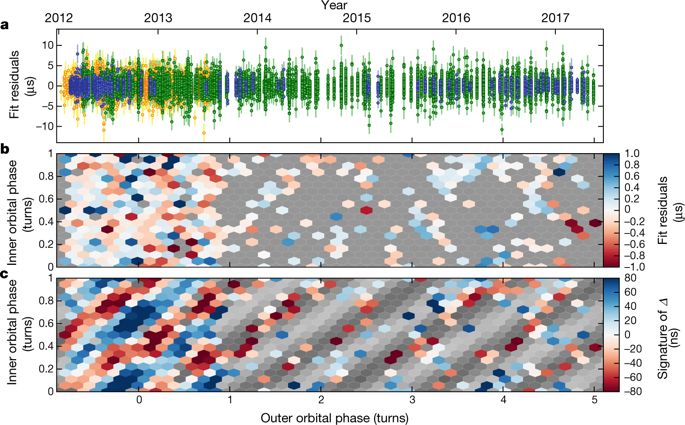Our official English website, www.x-mol.net, welcomes your
feedback! (Note: you will need to create a separate account there.)
Universality of free fall from the orbital motion of a pulsar in a stellar triple system
Nature ( IF 50.5 ) Pub Date : 2018-07-01 , DOI: 10.1038/s41586-018-0265-1 Anne M. Archibald , Nina V. Gusinskaia , Jason W. T. Hessels , Adam T. Deller , David L. Kaplan , Duncan R. Lorimer , Ryan S. Lynch , Scott M. Ransom , Ingrid H. Stairs
Nature ( IF 50.5 ) Pub Date : 2018-07-01 , DOI: 10.1038/s41586-018-0265-1 Anne M. Archibald , Nina V. Gusinskaia , Jason W. T. Hessels , Adam T. Deller , David L. Kaplan , Duncan R. Lorimer , Ryan S. Lynch , Scott M. Ransom , Ingrid H. Stairs

|
Einstein’s theory of gravity—the general theory of relativity1—is based on the universality of free fall, which specifies that all objects accelerate identically in an external gravitational field. In contrast to almost all alternative theories of gravity2, the strong equivalence principle of general relativity requires universality of free fall to apply even to bodies with strong self-gravity. Direct tests of this principle using Solar System bodies3,4 are limited by the weak self-gravity of the bodies, and tests using pulsar–white-dwarf binaries5,6 have been limited by the weak gravitational pull of the Milky Way. PSR J0337+1715 is a hierarchical system of three stars (a stellar triple system) in which a binary consisting of a millisecond radio pulsar and a white dwarf in a 1.6-day orbit is itself in a 327-day orbit with another white dwarf. This system permits a test that compares how the gravitational pull of the outer white dwarf affects the pulsar, which has strong self-gravity, and the inner white dwarf. Here we report that the accelerations of the pulsar and its nearby white-dwarf companion differ fractionally by no more than 2.6 × 10−6. For a rough comparison, our limit on the strong-field Nordtvedt parameter, which measures violation of the universality of free fall, is a factor of ten smaller than that obtained from (weak-field) Solar System tests3,4 and a factor of almost a thousand smaller than that obtained from other strong-field tests5,6.The accelerations of a pulsar and a white dwarf in a three-star system differ by at most a few parts per million, providing a much improved constraint on the universality of free fall.
中文翻译:

恒星三重系统中脉冲星轨道运动自由落体的普遍性
爱因斯坦的万有引力理论——广义相对论1——基于自由落体的普遍性,它规定所有物体在外部引力场中加速相同。与几乎所有替代的引力理论 2 不同,广义相对论的强等效原理要求自由落体的普遍性甚至适用于具有强自引力的物体。使用太阳系天体 3,4 对该原理的直接测试受到天体弱自引力的限制,而使用脉冲星-白矮星双星 5,6 的测试受到银河系弱引力的限制。PSR J0337+1715 是一个由三颗恒星组成的分级系统(恒星三重系统),其中由一颗毫秒射电脉冲星和一颗白矮星组成的双星在 1.6 天的轨道上与另一颗白矮星在 327 天的轨道上。该系统允许进行测试,比较外部白矮星的引力如何影响具有强大自引力的脉冲星和内部白矮星。在这里,我们报告脉冲星及其附近白矮星伴星的加速度相差不超过 2.6 × 10−6。为了进行粗略的比较,我们对强场 Nordtvedt 参数的限制,该参数衡量对自由落体普遍性的违反,比从(弱场)太阳系测试 3,4 获得的结果小 10 倍,几乎是比其他强场测试获得的小一千倍5,6.三星级系统中脉冲星和白矮星的加速度差异最多为百万分之几,对自由的普遍性提供了大大改进的约束。落下。
更新日期:2018-07-01
中文翻译:

恒星三重系统中脉冲星轨道运动自由落体的普遍性
爱因斯坦的万有引力理论——广义相对论1——基于自由落体的普遍性,它规定所有物体在外部引力场中加速相同。与几乎所有替代的引力理论 2 不同,广义相对论的强等效原理要求自由落体的普遍性甚至适用于具有强自引力的物体。使用太阳系天体 3,4 对该原理的直接测试受到天体弱自引力的限制,而使用脉冲星-白矮星双星 5,6 的测试受到银河系弱引力的限制。PSR J0337+1715 是一个由三颗恒星组成的分级系统(恒星三重系统),其中由一颗毫秒射电脉冲星和一颗白矮星组成的双星在 1.6 天的轨道上与另一颗白矮星在 327 天的轨道上。该系统允许进行测试,比较外部白矮星的引力如何影响具有强大自引力的脉冲星和内部白矮星。在这里,我们报告脉冲星及其附近白矮星伴星的加速度相差不超过 2.6 × 10−6。为了进行粗略的比较,我们对强场 Nordtvedt 参数的限制,该参数衡量对自由落体普遍性的违反,比从(弱场)太阳系测试 3,4 获得的结果小 10 倍,几乎是比其他强场测试获得的小一千倍5,6.三星级系统中脉冲星和白矮星的加速度差异最多为百万分之几,对自由的普遍性提供了大大改进的约束。落下。











































 京公网安备 11010802027423号
京公网安备 11010802027423号